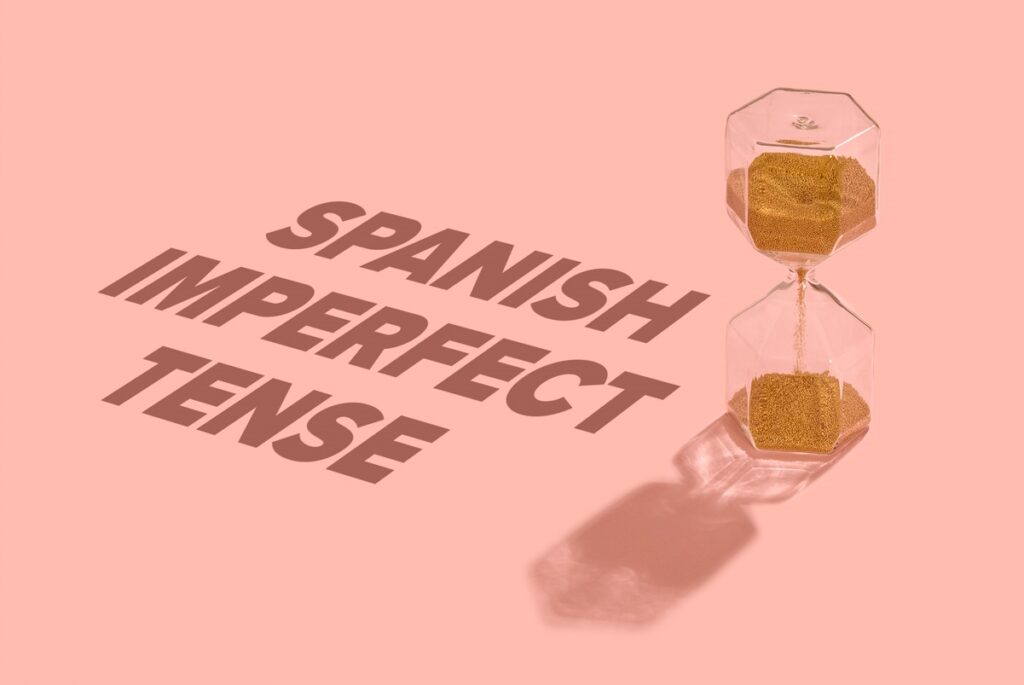
Using the Imperfect Tense in Spanish
Want to talk about past events or actions that were ongoing or occurred within an indefinite timeframe?
Think something like “We were playing games at home.” Here, you’re clearly talking about an event that has already happened, but aren’t saying anything about how long that event took place. (Were you playing the games for 20 minutes, one hour, etc.?)
That’s the imperfect tense in action, and Spanish has a similar concept.
In fact, the Spanish imperfect tense is arguably one of the most common past tenses in the language.
In this post, you’ll learn everything you need to know about the imperfect tense in Spanish—how to conjugate it, when to use it, common expressions used with it, irregular imperfect verbs and how it differs from the very similar preterite.
Contents
- What Is the Spanish Imperfect Tense?
- When to Use the Spanish Imperfect Tense
- Time Expressions Used with the Spanish Imperfect Tense
- Conjugating the Spanish Imperfect Tense
- Difference Between Spanish Imperfect and Preterite
- Spanish Imperfect Tense Quiz
- And One More Thing…
Download: This blog post is available as a convenient and portable PDF that you can take anywhere. Click here to get a copy. (Download)
What Is the Spanish Imperfect Tense?
The imperfect tense is one of the five past tenses in Spanish. It describes habitual past actions, actions that were ongoing or actions without a specific start and end time. It’s formed by adding -aba, -abas, -aba, -ábamos, -abais and -aban to -ar verbs, and -ía, -ías, -ía, -íamos, -íais and -ían to -er and -ir verbs.
It’s often confused with the preterite (simple past tense), as these are the two main past tenses in Spanish—but more on this later!
Here are a few examples of the imperfect tense in Spanish:
| Spanish | English |
|---|---|
| Juan cantaba una canción mientras Ana regaba las plantas. | Juan was singing a song while Ana was watering the plants. |
| Yo comía comida sana cuando estaba en la universidad. | I ate healthy food when I was in college. |
| Cuando él era pequeño, visitaba a su abuela todos los sábados. | When he was little, he visited his grandmother every Saturday. |
When to Use the Spanish Imperfect Tense
1. Habitual Actions in the Past
If an action took place repeatedly in the past, use the Spanish imperfect tense.
You’ll likely come across the verb soler (tend to, used to), which is always followed by an infinitive.
However, you don’t have to use soler to say “used to.” Instead, you can conjugate the infinitive verb into the imperfect.
For example:
| Spanish | English |
|---|---|
| María comía galletas cada tarde.
María solía comer galletas cada tarde. | María used to eat/would eat cookies every afternoon. |
| Juan sacaba a su perro a pasear tres veces al día. | Juan used to take/would take his dog for a walk three times a day. |
2. Describing the Past
The Spanish imperfect is the tense we use when making descriptions of the past. Descriptions could include physical traits, feelings, mental actions, conditions and states.
Take a look at these examples:
| Spanish | English | Type of Description |
|---|---|---|
| La abuela te quería mucho. | Grandma loved you very much. | feeling |
| Estaba muy enfermo. | He was very sick. | state |
| Pensaba en su futuro. | He thought about his future. | mental action |
| Era de noche y hacía mucho viento. La tormenta estaba casi encima de nosotros. | It was night and very windy. The storm was almost upon us. | conditions, setting the stage for a story |
| Wendy era alta y tenía los ojos azules. | Wendy was tall and had blue eyes. | physical description |
3. Past Actions in Progress
In English, when you have an ongoing action interrupted by another, you use the past continuous for the ongoing action and the past simple for the sudden one:
I was taking a bath when you called.
Similarly in Spanish, we use the imperfect tense for the ongoing action and the preterite for the interrupting one.
For example:
Me estaba bañando cuando llamaste.
I was taking a bath when you called.
However, you don’t need an interruption to describe past ongoing actions. You can use the imperfect to make it clear that you’re talking about an action in progress:
| Spanish | English |
|---|---|
| Antonio caminaba hacia el parque. | Antonio was walking toward the park. |
| Ayer a las 5 de la tarde estaba leyendo un libro. | Yesterday at 5 p.m. I was reading a book. |
4. Times and Dates
Times and dates in the present tense use the present simple. We use the imperfect when talking about times and dates in the past.
For example:
| Spanish | English |
|---|---|
| Eran las 3 de la mañana cuando volviste. | It was 3 a.m. when you came back. |
| Era el 15 de abril. Estaba soleado y me sentía muy feliz. | It was April 15. It was sunny and I was feeling very happy. |
| Era el año 1939, y nunca más volvería a verlo. | It was 1939, and I would never see him again. |
5. Talking About Age
When talking about how old you were at a certain time period, you’d need to use the imperfect form of the verb tener (to have).
You’d also use the imperfect even if you don’t want to give a specific age, but instead want to say something like “when I was young.”
For example:
| Spanish | English |
|---|---|
| Yo empecé a aprender español cuando tenía 25 años. | I started learning Spanish when I was 25 years old. |
| Mi papá tenía 8 años cuando se mudó a los Estados Unidos. | My dad was 8 years old when he moved to the United States. |
| Cuando era pequeña, jugaba en la calle con mis primos. | When I was little, I would play in the street with my cousins. |
Time Expressions Used with the Spanish Imperfect Tense
Just as the English present simple is associated with time expressions such as “never,” “always,” “often,” “sometimes,” etc., Spanish also has a set of expressions often used with the imperfect tense.
Here are some of those expressions:
| Expression | Meaning | Example |
|---|---|---|
| Cada día
Cada semana Cada mes Cada año Cada domingo | Every day Every week Every month Every year Every Sunday | Iba a almorzar a la casa de mi abuela cada sábado.
(I used to go have lunch at my grandma’s house every Saturday.) |
| De vez en cuando | From time to time | Me escribía de vez en cuando.
(She wrote to me from time to time.) |
| Frecuentemente
con frecuencia | Frequently | Nos veíamos con frecuencia durante el verano.
(We used to see each other frequently during summer.) |
| En aquel tiempo
En aquella época | At that time, during that time | En aquel tiempo, ninguno de nosotros tenía un ordenador.
(At that time, none of us had a computer.) |
| Generalmente | Usually | Generalmente sacabas mejores notas que yo.
(You usually got better grades than me.) |
| A menudo | Often | Íbamos a pescar a menudo cuando estábamos de vacaciones.
(We would often go fishing when we were on holiday.) |
| Muchas veces | Many times | Muchas veces trabajaba los fines de semana.
(Many times I would work on weekends.) |
| Nunca | Never | María nunca llegaba tarde.
(María would never arrive late.) |
| Siempre | Always | Siempre comíamos helado los viernes.
(We always used to eat ice cream on Fridays.) |
Conjugating the Spanish Imperfect Tense
Regular Verbs
Remember that each Spanish verb falls into one of three conjugations depending on their ending: -ar verbs, –er verbs and –ir verbs.
Something that makes the imperfect easier than other tenses is that the conjugations for -er and -ir verbs are the same.
Here’s how you conjugate these three verbs in the imperfect tense:
| Subject | -AR Endings | -ER Endings | -IR Endings |
|---|---|---|---|
| Yo | -aba | -ía | -ía |
| Tú | -abas | -ías | -ías |
| Él
Ella Usted | -aba | -ía | -ía |
| Nosotros | -ábamos | -íamos | -íamos |
| Vosotros | -abais | -íais | -íais |
| Ellos
Ellas Ustedes | -aban | -ían | -ían |
Now that you know the conjugations, let’s look at some examples with -ar, -er and -ir verbs:
| Subject | Hablar (To Speak) | Comer (To Eat) | Escribir (To Write) |
|---|---|---|---|
| Yo | hablaba | comía | escribía |
| Tú | hablabas | comías | escribías |
| Él
Ella Usted | hablaba | comía | escribía |
| Nosotros | hablábamos | comíamos | escribíamos |
| Vosotros | hablabais | comíais | escribíais |
| Ellos
Ellas Ustedes | hablaban | comían | escribían |
Irregular Verbs
Ser (to be), ir (to go) and ver (to see, to watch) are the only three irregular verbs in the imperfect tense:
| Subject | Ser (To Be) | Ir (To Go) | Ver (To See/Watch) |
|---|---|---|---|
| Yo | era | iba | veía |
| Tú | eras | ibas | veías |
| Él
Ella Usted | era | iba | veía |
| Nosotros | éramos | íbamos | veíamos |
| Vosotros | erais | ibais | veíais |
| Ellos
Ellas Ustedes | eran | iban | veían |
But even though these verbs are irregular, they do follow a certain pattern!
- Ser uses the same endings as regular -er verbs but without the í
- Ir uses the same endings as regular -ar verbs but drops the first a
- Ver has the regular endings it should—there’s just an additional e that remains from the infinitive
Difference Between Spanish Imperfect and Preterite
The difference between the Spanish imperfect and preterite is that the imperfect is used to talk about actions that were ongoing in the past, while the preterite is used with past actions that had a specific start and end.
Put in another way, the imperfect is usually used to tell stories or talk about past routines or habits (by using “used to”), while the preterite is used for actions that only happened a specified number of times or interrupted a previous ongoing action.
Here are some example sentences in the past imperfect followed by sentences in the preterite, so you can compare them side by side:
| Spanish Imperfect | Spanish Preterite |
|---|---|
| Caminaba con mi esposo cada mañana.
(I walked with my husband every morning.) | Caminé con mi esposo esta mañana.
(I walked with my husband this morning.) |
| Iba al mercado los miércoles.
(I went to the market on Wednesdays.) | Fui al mercado ayer.
(I went to the market yesterday.) |
Here’s a sentence that features both tenses:
Estabas limpiando la casa cuando llegué.
You were cleaning the house when I arrived.
For more practice with the preterite vs. imperfect and to learn more differences, check out our complete guide here.
You can also see and hear examples of both tenses (and more) while watching authentic Spanish content on a program like FluentU.
FluentU takes authentic videos—like music videos, movie trailers, news and inspiring talks—and turns them into personalized language learning lessons.
You can try FluentU for free for 2 weeks. Check out the website or download the iOS app or Android app.
P.S. If you decide to sign up now, you can take advantage of our current sale!

Spanish Imperfect Tense Quiz
You’ve learned how and when to use the Spanish imperfect tense. Now, it’s time to quiz yourself.
Choose the correct imperfect conjugation to replace the infinitive verb in brackets in each sentence below. Complete all ten questions to see where you stand with the imperfect tense!
(When I was a kid, I used to play in the park every day.)

(He always used to arrive late to meetings.)

(We used to live in a small house near the sea.)

(During the summer, we used to visit our grandparents in the countryside.)

(Before, she used to work as an English teacher.)

(They used to sing traditional songs at parties.)

(I always used to walk to school when I was young.)

(My parents used to tell me stories before sleeping.)

(In those times, technology wasn't as advanced as it is now.)

(On Sundays, we used to go to the park and spend hours playing soccer.)

The imperfect tense is one of the simpler Spanish tenses that can feel like a relief compared to many other tenses.
If you’re not there yet, keep practicing and you’ll soon get the hang of it!
Download: This blog post is available as a convenient and portable PDF that you can take anywhere. Click here to get a copy. (Download)
And One More Thing…
If you've made it this far that means you probably enjoy learning Spanish with engaging material and will then love FluentU.
Other sites use scripted content. FluentU uses a natural approach that helps you ease into the Spanish language and culture over time. You’ll learn Spanish as it’s actually spoken by real people.
FluentU has a wide variety of videos, as you can see here:

FluentU brings native videos within reach with interactive transcripts. You can tap on any word to look it up instantly. Every definition has examples that have been written to help you understand how the word is used. If you see an interesting word you don’t know, you can add it to a vocab list.

Review a complete interactive transcript under the Dialogue tab, and find words and phrases listed under Vocab.

Learn all the vocabulary in any video with FluentU’s robust learning engine. Swipe left or right to see more examples of the word you’re on.

The best part is that FluentU keeps track of the vocabulary that you’re learning, and gives you extra practice with difficult words. It'll even remind you when it’s time to review what you’ve learned. Every learner has a truly personalized experience, even if they’re learning with the same video.
Start using the FluentU website on your computer or tablet or, better yet, download the FluentU app from the iTunes or Google Play store. Click here to take advantage of our current sale! (Expires at the end of this month.)







